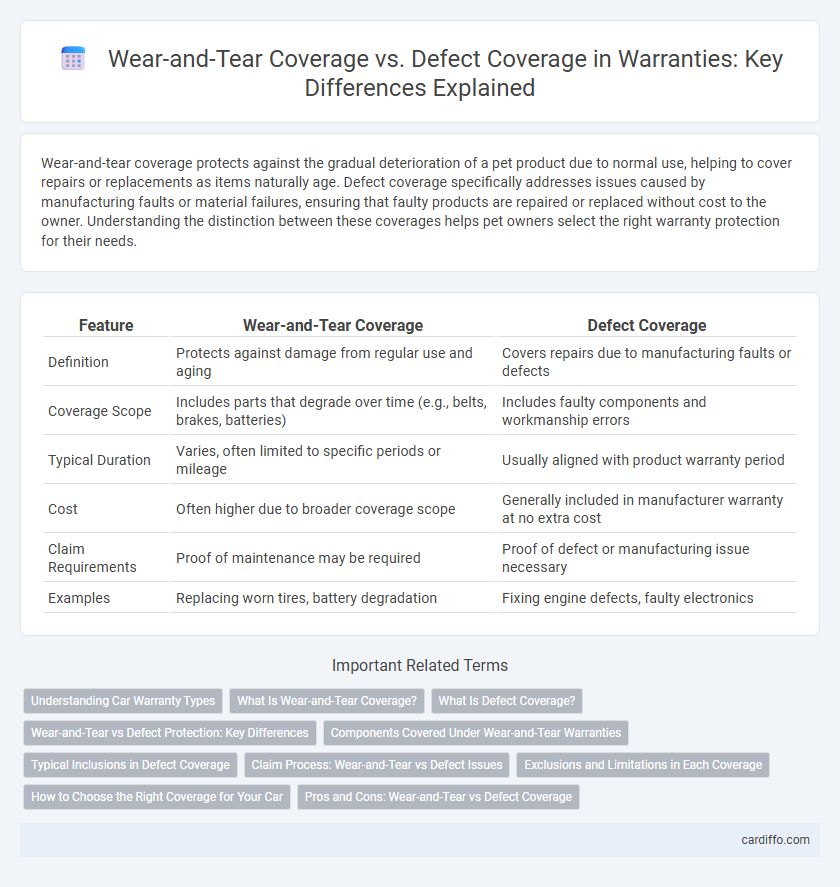Wear-and-tear coverage protects against the gradual deterioration of a pet product due to normal use, helping to cover repairs or replacements as items naturally age. Defect coverage specifically addresses issues caused by manufacturing faults or material failures, ensuring that faulty products are repaired or replaced without cost to the owner. Understanding the distinction between these coverages helps pet owners select the right warranty protection for their needs.
Table of Comparison
| Feature | Wear-and-Tear Coverage | Defect Coverage |
|---|---|---|
| Definition | Protects against damage from regular use and aging | Covers repairs due to manufacturing faults or defects |
| Coverage Scope | Includes parts that degrade over time (e.g., belts, brakes, batteries) | Includes faulty components and workmanship errors |
| Typical Duration | Varies, often limited to specific periods or mileage | Usually aligned with product warranty period |
| Cost | Often higher due to broader coverage scope | Generally included in manufacturer warranty at no extra cost |
| Claim Requirements | Proof of maintenance may be required | Proof of defect or manufacturing issue necessary |
| Examples | Replacing worn tires, battery degradation | Fixing engine defects, faulty electronics |
Understanding Car Warranty Types
Wear-and-tear coverage protects against damage caused by normal usage, such as brake pads or tire wear, whereas defect coverage addresses manufacturing faults or faulty materials that compromise vehicle performance. Understanding car warranty types helps consumers differentiate between routine maintenance expenses and repairs covered due to factory defects. Most new car warranties combine both coverage types to provide comprehensive protection within specified time or mileage limits.
What Is Wear-and-Tear Coverage?
Wear-and-tear coverage protects against damage from normal use and aging of a product, covering parts that naturally degrade over time, such as batteries, mechanical wear, and cosmetic deterioration. This type of warranty ensures that routine usage issues are addressed without extra cost, helping maintain product performance throughout its expected lifespan. Unlike defect coverage, which focuses on manufacturing faults, wear-and-tear coverage handles the gradual decline caused by everyday operation.
What Is Defect Coverage?
Defect coverage refers to the warranty protection against failures or malfunctions caused by manufacturing flaws or material defects, ensuring that repairs or replacements are provided at no cost to the customer. This type of coverage excludes damage resulting from normal wear and tear or user misuse, focusing solely on inherent product faults. Defect coverage is critical for maintaining product reliability and consumer confidence during the warranty period.
Wear-and-Tear vs Defect Protection: Key Differences
Wear-and-tear coverage protects against gradual deterioration caused by normal use, while defect coverage addresses faults arising from manufacturing or material defects. Wear-and-tear policies typically exclude damage resulting from accidents or improper use, focusing instead on the expected lifespan of components. Defect protection ensures repair or replacement for items failing due to inherent flaws, often within a specified warranty period.
Components Covered Under Wear-and-Tear Warranties
Wear-and-tear warranties primarily cover components subject to regular use and gradual deterioration, such as brake pads, tires, and clutches. These warranties exclude defects in materials or workmanship, which fall under defect coverage. Understanding the specific parts protected helps consumers select optimal warranty plans tailored to their vehicle maintenance needs.
Typical Inclusions in Defect Coverage
Defect coverage in warranties typically includes repairs or replacements for manufacturing flaws, faulty materials, and workmanship errors affecting the product's performance or safety. This coverage excludes damage caused by regular wear-and-tear, accidents, misuse, or environmental factors. Common inclusions are defective components, structural failures, and malfunctions that arise within the warranty period under normal usage conditions.
Claim Process: Wear-and-Tear vs Defect Issues
Wear-and-tear coverage claims typically require proof of regular maintenance and documentation of gradual deterioration over time, while defect coverage claims focus on proving the product malfunctioned due to manufacturing faults. Claim processing for wear-and-tear often involves inspections to assess the extent of use, whereas defect claims prioritize diagnostic tests and manufacturer evaluations. Timely submission and adherence to warranty terms are crucial for both types to ensure successful claim approval.
Exclusions and Limitations in Each Coverage
Wear-and-tear coverage typically excludes damages caused by accidental misuse or neglect, limiting reimbursement to gradual deterioration from normal use. Defect coverage excludes issues arising from improper installation, unauthorized repairs, or external factors, focusing solely on inherent product faults. Both warranties often impose time-based limits and caps on claim amounts, restricting eligibility and financial compensation.
How to Choose the Right Coverage for Your Car
Choosing the right coverage for your car depends on understanding the difference between wear-and-tear coverage and defect coverage. Wear-and-tear coverage protects against damage caused by regular use, such as brake pad or tire wear, while defect coverage covers repairs due to manufacturing faults or design flaws. Evaluate your vehicle's age, mileage, and driving habits to determine if you need protection against everyday deterioration or unexpected mechanical failures.
Pros and Cons: Wear-and-Tear vs Defect Coverage
Wear-and-tear coverage protects against gradual deterioration from normal use, offering broader protection but often with higher premiums and potential claim limitations. Defect coverage targets manufacturer faults, typically resulting in fewer disputes and lower costs but excludes damage from regular usage. Choosing between the two depends on balancing comprehensive protection needs against budget constraints and risk tolerance for component aging.
Wear-and-Tear Coverage vs Defect Coverage Infographic

 cardiffo.com
cardiffo.com